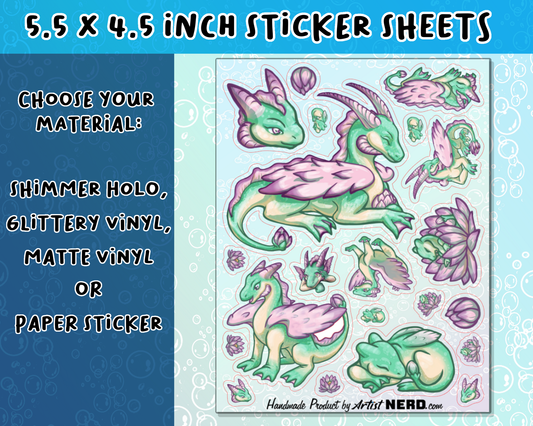Collection: Loliponds
New Species discovered!
Welcome the Loliponds
(Lolies, Lolips, Petal-pups)
Loliponds are medium sized freshwater aquatic dragons with four webbed feet, two scaled wings, frills under their chins and along their spine ending with a unique flower-shaped organ used for transferring oxygen while under water. They have velvety wet skin over most of their body with harder petal-shaped scales on their wings and around their tail-organ which they use for protection. They sport a variety of colors and patterns on their scales and frills that mimic those of lilies which the most common being the pink in color.
Diet: primarily plants, seeds, cereal and fruit they may also add insects, worms, seeds, fry, frogs, and especially when nesting.
Home: Loliponds need lily pads to nest and incubate their young. When not nesting they can live in any environment providing they receive adequate access to fresh water or frequent misting. They pair well with fish ponds as they are gentle in nature though the may eat the fish eggs or small fry.
Temperament: Loliponds are a gentle, quiet and intelligent creatures. They communicate with elaborate gestures; head bobbing and flaring of wings or frills, chirps and whines. When alarmed they will issue a series of honks to alert others of danger or their surprise.
Life stages:
Loliponds eggs have multiple layers of shell to protect them and provide additional nutrients for the growing chick inside. The chicks can swim immediately after hatchling but are usually to tired to do so for the first day or two. Chicks are primarily green and butter yellow with a tint of color on their wings and tail.
Fledgling Loliponds have begun to take on their adult colors and grow their ribbed horns. They enter this stage at 4 weeks. The age of the chick can be gauged but the shape and number of ribs on the horns. Rounded horns are from younger fledglings while pointed horns usually means the fledgling is near to the adolescent stage.
Adolescent Loliponds are nearly identical to adult Loliponds and reach this stage at 6 months of age. Adolescents may cause a stir within the pond before reaching adulthood as they go through a period of attention seeking from their peers or potential mates.
Loliponds reach adulthood at 1 year of age and may at this time choose a partner. Females lay eggs in quiet pools then place eggs on water lily pads. Eggs are soft and almost smooth with slight indentations where the shell will separate upon hatching. The outer shell will create a tough shell to protect the embryo within a few hours of laying. If placed upon a lily pad before the egg shell has hardened the egg will attach to the lily pad and which it will receive nutrients from the plant. Clutch sizes range from one to four eggs laid within a day or two of each other with the average size being two to three per clutch. Both male and female Loliponds will incubate the eggs holding them close to their underbelly until hatching (20-21 days). Mature females may lay two clutches within a single breeding season while first year females will only produce one during the middle of the breeding season. This natural breeding mechanic spaces out the heavy tax on the available resources of food and parental care.
Lolipond design and species copywrite by Marsi Souther. Use with permission.




